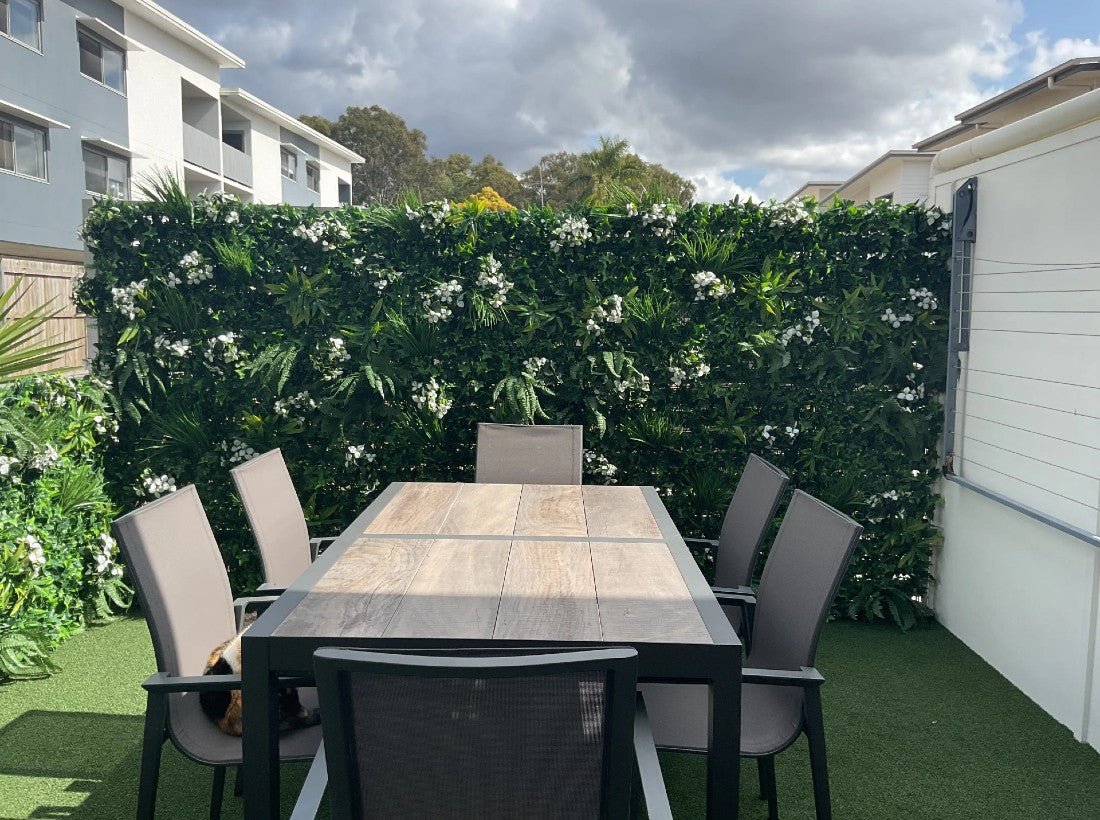It’s time for us to tackle a never-ending debate, one with passionate opinions on both sides.
It’s time for you to get all the facts before choosing whether to go with real vs artificial plants. And to have all the facts, you need a comprehensive overview.
But before we get into it, let’s address the elephant in the room: our bias.
We sell artificial greenery. It’s what we make our living out of. But we’re not ones for pulling the wool over your eyes, partly because it’s highly unethical, but partly because you can already find similar information everywhere else on the Internet.
So, why lie?
Since we’re a family-owned business, we value transparency. We can tell you why we love artificial plants, but we can also tell you that, for some people, real plants are a much better option.
The best way to ensure you get a decor element you’ll love for longer than a few months is to consider the pros and cons of every option.
And in this blog, we’ll talk about the pros and cons of fake vs real plants, so that you can make an informed decision when the time comes.
Let’s dive in.
Real vs. Artificial Plants: Pros and Cons

We’ll get into the nitty gritty straight away - no sugarcoating allowed.
Below, you’ll find the (unbiased) advantages and disadvantages of artificial and real plants. The only thing we’ll share beforehand is that there is no right choice when it concerns decor. There are nuances and personal preferences you need to consider, but regardless, you won’t make the wrong decision because such a thing doesn’t exist.
With that out of the way, let’s put our plant types under a microscope:
Pros of Real Plants
Nature is the most talented artist, which is why it’s been the muse for numerous industries and disciplines, including ours. The advantages of natural greenery stretch far beyond beauty and include:
- Air purification: A prominent NASA study conducted in 1989 reported that the roots and soil of houseplants improved the quality of the air in a sealed spacecraft. Yet, it’s important to mention that, over the years, researchers discovered that the impact isn’t significant and may even be non-existent.
- Sense of achievement: Some people think of their plants as projects. They feel joy and fulfillment when they can keep a plant thriving for long periods of time, which may improve self-esteem and gain a sense of self-worth.
- Mood boosting: The Journal of Physiological Anthropology determined that houseplants have a soothing effect on our minds. Gardening and plant care were found to lower the stress response and lead to pleasant feelings and emotions.
- Reduction of sick days: A study by the University of Technology, Sydney (UTS) revealed that real plants reduce worker sick days by over 20%. This tells us that the more plants a person has around, the fewer sick days they’re likely to take from work.
Cons of Real Plants
There are always 2 sides to a coin. Now, let’s talk about some reasons why you may not want to buy real plants, such as:
- Presence of pests and insects: Real plants are VIP lounges for insects and pests. The leaves, stems, and soil are the perfect environment for aphids, mites, and gnats. If you don’t want pests crawling around your living space and forcing you to use pesticides, you may decide against natural greenery.
- Threat of allergies: Natural greenery can trigger allergies for many people due to the pollen they release. Beyond this, the mold that grows in moist soil can also become a hidden threat that circulates allergens through the air.
- Threat of toxicity for pets: Plants can pose a danger to pets due to potential toxicity. Many common household plants can be harmful or even fatal to pets if ingested. Even plants that seem harmless can have toxic properties for animals, and as a pet owner, you may need to be on alert constantly.
- High-maintenance: If you don’t have the time or the energy to keep up with watering schedules, pruning, and repotting, you might struggle with real plants. Some plants can be especially temperamental, leading you to end up with wilton, brown leaves or an entire plant in decline in a matter of days.
Pros of Artificial Plants
Since artificial plants are man-made, manufacturers can make them as good or bad as they like. This aspect also means that the manufacturer can improve many features in their designs to make them suitable for various applications. The most significant advantages are:
- Durability: Good manufacturers create artificial plants with longevity in mind. Since they’re plastic, they’re hardier than real plants. Fake plants won’t struggle with temperature shifts, pests, or neglect. With the right care, they can even last for 5 years or more.
- Affordability: While faux plants come with a higher upfront investment, they’re more cost-effective in the long run because you’re not purchasing fertilizers or pest control treatments. Plus, you won’t have any recurring costs because you won’t consider water costs or maintenance tools.
- Low-maintenance: There’s no need to water, prune, or trim artificial plants. You also won’t need to adjust their placement based on location or ever think about repotting or relocating. The most you’ll need to do is dust them off and call it a day.
- Customization: Artificial plants are great for people who want hassle-free variety. You can choose from many plant types, sizes, and colors to match your space. You can also ask for manufacturers to create custom fauxliege just for you.
Out of these, maintenance is hands down the biggest advantage of artificial plants. Here’s how it stacks up when compared to the upkeep of real plants:
|
Task |
Real |
Artificial |
|
Watering |
✔️ |
❌ |
|
Fertilizing |
✔️ |
❌ |
|
Pruning |
✔️ |
❌ |
|
Trimming |
✔️ |
❌ |
|
Dusting |
✔️ |
✔️ |
|
Pest control |
✔️ |
❌ |
|
Spray cleaning |
✔️ |
✔️ |
Cons of Artificial Plants
- No growth: If you take pride in your ability to take care of a sprout long enough for it to become a large plant, you won’t derive enjoyment from artificial plants. Since they don’t grow, you might sense that something is missing and feel disappointed later on.
- Lack of realism: If you don’t invest in a high-quality artificial plant and buy your decor without scrutinizing it from every angle, you’ll get a faux plant that looks more like a toy than anything else. Unfortunately, bad fake plants are often more common than good ones.
- Upfront costs: A lot goes on behind the scenes of artificial plant design and production. Initially, fake plants are more expensive than real ones and may set you back more than you’re comfortable with. While the end goal for faux foliage is longevity, some budgets can’t stretch that much to accommodate the price.
- Fading: Depending on where you buy your artificial plants, they may fade quicker than you expect if exposed to the sun for longer. You can extend their lifespan by requesting built-in UV resistance or spraying them with a UV spray, but if they’re lower quality, they won’t stay vibrant for too long.
Are Fake Plants Tacky in 2024?
No.
‘Tacky’ is subjective. What might look wonderful for you could be an eyesore for someone else. As a result, the other person will describe the same object with different adjectives, and tacky may be one of them.

Don’t base your decision on whether to buy real or artificial plants on external factors like other people’s opinions, likes, and dislikes. In fact, the only thing you should be looking at is your vision - what do you like and what can you realistically manage to maintain?
Artificial plants have advantages and disadvantages, just like real plants. Ultimately, the choice boils down to which one trumps the other in your eyes.
Faux plants have become more popular these past few years as more people lead busier lives. Yet, if you have a green thumb and can find the time to care for a real plant, it’s a great idea to get a natural one.
Don’t let peer pressure deter you from buying decor you know you’ll love. After all, people crying ‘tacky’ won’t be looking at your plant every day - it’ll be you who does that, so it should be your decision entirely.
Need help picking the best artificial plant for your space? Take this short quiz.


